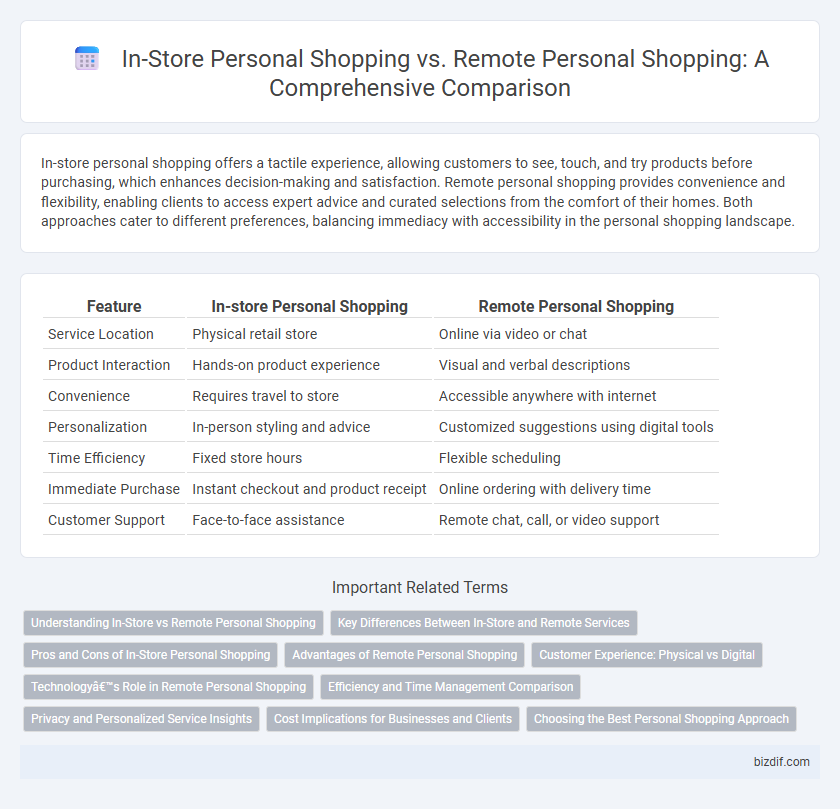In-store personal shopping offers a tactile experience, allowing customers to see, touch, and try products before purchasing, which enhances decision-making and satisfaction. Remote personal shopping provides convenience and flexibility, enabling clients to access expert advice and curated selections from the comfort of their homes. Both approaches cater to different preferences, balancing immediacy with accessibility in the personal shopping landscape.
Table of Comparison
| Feature | In-store Personal Shopping | Remote Personal Shopping |
|---|---|---|
| Service Location | Physical retail store | Online via video or chat |
| Product Interaction | Hands-on product experience | Visual and verbal descriptions |
| Convenience | Requires travel to store | Accessible anywhere with internet |
| Personalization | In-person styling and advice | Customized suggestions using digital tools |
| Time Efficiency | Fixed store hours | Flexible scheduling |
| Immediate Purchase | Instant checkout and product receipt | Online ordering with delivery time |
| Customer Support | Face-to-face assistance | Remote chat, call, or video support |
Understanding In-Store vs Remote Personal Shopping
In-store personal shopping provides immediate, tactile experiences allowing customers to physically interact with products and receive real-time assistance from experts. Remote personal shopping leverages digital tools such as video calls and online catalogs to offer personalized guidance without location constraints, enhancing convenience and accessibility. Understanding the distinct benefits of both approaches enables retailers to tailor services that meet diverse customer preferences and optimize satisfaction.
Key Differences Between In-Store and Remote Services
In-store personal shopping offers a tactile, immersive experience where customers interact directly with products and receive immediate, personalized assistance. Remote personal shopping leverages digital tools and virtual consultations, providing convenience and access to a wider range of items without physical store visits. Key differences include the sensory engagement of in-store shopping versus the flexibility and broader inventory options available through remote services.
Pros and Cons of In-Store Personal Shopping
In-store personal shopping offers immediate, tactile interaction with products, allowing shoppers to evaluate quality, fit, and color firsthand, enhancing decision confidence. The personalized assistance from trained staff provides tailored recommendations and real-time style advice, creating a more engaging and efficient shopping experience. However, it can be time-consuming and limited by store hours or location, with potential exposure to crowds and less convenience compared to remote shopping options.
Advantages of Remote Personal Shopping
Remote personal shopping offers unparalleled convenience by allowing customers to browse and select products from the comfort of their homes. Enhanced by virtual styling sessions and real-time video consultations, this service provides personalized recommendations without geographic limitations. Time efficiency and access to a broader range of inventory make remote personal shopping a superior choice for busy individuals seeking tailored fashion solutions.
Customer Experience: Physical vs Digital
In-store personal shopping offers customers a tactile, immersive experience with immediate access to products, personalized assistance, and sensory engagement. Remote personal shopping leverages digital tools, providing convenience through virtual consultations, curated selections, and seamless online transactions. Both methods prioritize personalized service, but in-store emphasizes physical interaction, while remote focuses on digital flexibility and accessibility.
Technology’s Role in Remote Personal Shopping
Remote personal shopping leverages advanced technologies such as augmented reality, AI-driven style recommendations, and real-time video consultations to create immersive and personalized experiences. Artificial intelligence algorithms analyze customer preferences and purchase history to suggest tailored products, enhancing satisfaction and efficiency. High-quality video streaming and virtual try-ons bridge the gap between physical stores and online access, enabling shoppers to make confident decisions from home.
Efficiency and Time Management Comparison
In-store personal shopping offers immediate product access and personalized assistance, reducing time spent on browsing and decision-making. Remote personal shopping leverages digital tools and virtual consultations to streamline selections, enabling efficient planning without travel time. Both methods enhance time management by catering to different customer preferences and schedules.
Privacy and Personalized Service Insights
In-store personal shopping offers enhanced privacy by enabling face-to-face interactions within controlled environments, ensuring confidential discussions about preferences and purchases. Remote personal shopping leverages digital tools to provide personalized service while safeguarding data through encryption and secure platforms, allowing clients to shop discreetly from any location. Both methods prioritize tailored experiences, but in-store interactions offer immediate sensory engagement, whereas remote shopping emphasizes convenience and data security.
Cost Implications for Businesses and Clients
In-store personal shopping incurs higher overhead costs for businesses due to expenses such as retail space, staff salaries, and in-person amenities, which can lead to premium pricing for clients. Remote personal shopping reduces operational costs by eliminating physical store requirements, allowing businesses to offer more competitive rates and flexible pricing models. Clients benefit from cost savings and greater convenience with remote services, while businesses can scale their offerings without significant investment in physical infrastructure.
Choosing the Best Personal Shopping Approach
In-store personal shopping offers tactile experiences and immediate product access, making it ideal for customers who value hands-on selection and instant gratification. Remote personal shopping excels in convenience and accessibility, providing personalized recommendations through virtual consultations and online tools. Selecting the best personal shopping approach depends on individual preferences for sensory engagement, time availability, and the desire for expert guidance tailored to either physical or digital environments.
In-store personal shopping vs Remote personal shopping Infographic

 bizdif.com
bizdif.com